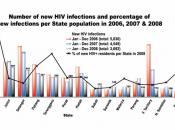Introduction
AIDS stands for Acquired Immune Deficiency Syndrome. It is also known as Acquired Immunodeficiency Syndrome. AIDS is a collection of infections and syndroms in humans. This is caused by specific damage to the immune system by the human immunodeficiency virus (HIV). Two kinds of HIV infect humans: HIV-1 and HIV-2. HIV-1 is more dangerous and more easily transmitted. HIV-1 is the source of the majority of HIV infections throughout the world, while HIV-2 is less easily transmitted and is largely restricted to West Africa.
First cases of AIDS
The first documented HIV-1 infection and was discovered in 1959, in the blood sample of a man from Belgian Congo. Another early case of AIDS happened on a Haitian man in 1559, when he suffered of shortness of breath, extreme fatigue, high fever and rapid weight loss. He died the same year from a very rare kind of pneumonia. AIDS was discovered on June 5, 1981.
HIV-1 evolved from a Simian Immunodeficiency virus (SIV) found in a chimpanzee. HIV-2 evolved from a different strain of SIV found in Old World monkeys.
Retroviruses
A Retrovirus is an enveloped virus processing an RNA genome, which replicates via a DNA intermediate. Retroviruses use the enzyme reverse transcriptase to transcript its genome from RNA to DNA, so that it can be integrated to the host's genome using an enzyme and it can multiply itself.
How the HIV affects the immune system
HIV primarily infects the vital components of the human immune system, for example helper T-cells and then destroys them. It also infects macrophages, which are cells that engulf and digest pathogens, and it also attacks dendritic cells, which are cells that interact with T and B cells to begin and shape the immune response. The virus also directly and indirectly kills CD4+T cells,


